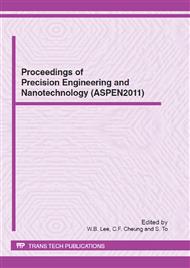p.1
p.7
p.13
p.19
p.25
p.30
p.36
p.42
Multiscale Modeling Study on the Nanometric Cutting Process of CaF2
Abstract:
The hierarchical approach of multi-scale modelling was adopted to study the nanometric cutting process of calcium fluoride. Then fly cutting experiments of CaF2 were performed to analyze the influence of cutting speed upon the surface roughness of CaF2. The results of FEM simulations show that larger negative rake angle and larger cutting edge radius lead to lower tensile stress in the cutting region. Tangential cutting force will first increase with an increase of negative rake angle and cutting edge radius, and then start to decrease with them. The tensile stress in the cutting region will increase with cutting depth at first, and then become stable when it reaches a certain extent. The specific cutting force increases rapidly with decrease of cutting depth, showing an obvious size effect. Within the range of cutting speeds adopted in the simulations, cutting speed has little influence on the tensile stress in the cutting region. And the results of fly cutting experiments show that cutting speed has little influence on the surface roughness of a machined surface under the cutting speeds adopted. This verifies the validity of the simulation result to some extent.
Info:
Periodical:
Pages:
13-18
Citation:
Online since:
June 2012
Authors:
Keywords:
Price:
Сopyright:
© 2012 Trans Tech Publications Ltd. All Rights Reserved
Share:
Citation:


